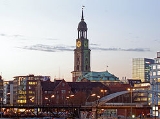
St. Michaelis' Church, Hamburg
Encyclopedia
St. Michaelis, colloquially called Michel (ˈmɪçəl), is one of Hamburg
's five main Protestant
churches (Hauptkirchen) and the most famous church in the city. St. Michaelis is a landmark
of the city. It is dedicated to the archangel Michael
. A large bronze
statue, standing above the portal of the church shows the archangel conquering the devil
.
The 132-metre high Baroque spire totally covered with copper
is a prominent feature of Hamburg’s skyline and has always been a landfall mark for ships sailing up the river Elbe
.
. The original church has been replicated and built in 9 different cities around the world.
In 1786, a new construction following the design of Johann Leonhard Prey and Ernst Georg Sonnin was completed. This is the church as we know it today. It was reconstructed twice in the 20th century: after catching fire in 1906 during construction work and after the bombings of 1944 and 1945. Since 1983, renovation is ongoing: first the spire and then the roof.
Offering 2,500 seats, the Michel is the largest church in Hamburg. The spire, which offers an excellent view over the city and the harbour, can be climbed, but there also is a lift.
Hamburg
-History:The first historic name for the city was, according to Claudius Ptolemy's reports, Treva.But the city takes its modern name, Hamburg, from the first permanent building on the site, a castle whose construction was ordered by the Emperor Charlemagne in AD 808...
's five main Protestant
Evangelical Church in Germany
The Evangelical Church in Germany is a federation of 22 Lutheran, Unified and Reformed Protestant regional church bodies in Germany. The EKD is not a church in a theological understanding because of the denominational differences. However, the member churches share full pulpit and altar...
churches (Hauptkirchen) and the most famous church in the city. St. Michaelis is a landmark
Landmark
This is a list of landmarks around the world.Landmarks may be split into two categories - natural phenomena and man-made features, like buildings, bridges, statues, public squares and so forth...
of the city. It is dedicated to the archangel Michael
Michael (archangel)
Michael , Micha'el or Mîkhā'ēl; , Mikhaḗl; or Míchaël; , Mīkhā'īl) is an archangel in Jewish, Christian, and Islamic teachings. Roman Catholics, Anglicans, and Lutherans refer to him as Saint Michael the Archangel and also simply as Saint Michael...
. A large bronze
Bronze
Bronze is a metal alloy consisting primarily of copper, usually with tin as the main additive. It is hard and brittle, and it was particularly significant in antiquity, so much so that the Bronze Age was named after the metal...
statue, standing above the portal of the church shows the archangel conquering the devil
Devil
The Devil is believed in many religions and cultures to be a powerful, supernatural entity that is the personification of evil and the enemy of God and humankind. The nature of the role varies greatly...
.
The 132-metre high Baroque spire totally covered with copper
Copper
Copper is a chemical element with the symbol Cu and atomic number 29. It is a ductile metal with very high thermal and electrical conductivity. Pure copper is soft and malleable; an exposed surface has a reddish-orange tarnish...
is a prominent feature of Hamburg’s skyline and has always been a landfall mark for ships sailing up the river Elbe
Elbe
The Elbe is one of the major rivers of Central Europe. It rises in the Krkonoše Mountains of the northwestern Czech Republic before traversing much of Bohemia , then Germany and flowing into the North Sea at Cuxhaven, 110 km northwest of Hamburg...
.
History
The present church building is the third one at this site. The first one was built from 1647 to 1669. It became the church of the new town (Neustadt), which was created in 1625 inside the new city walls, and which grew steadily since. In 1687, the Michel became the fifth main church (Hauptkirche), and the new town (Neustadt) became a parish. That church was destroyed on March 10, 1750, by a lightning strikeLightning
Lightning is an atmospheric electrostatic discharge accompanied by thunder, which typically occurs during thunderstorms, and sometimes during volcanic eruptions or dust storms...
. The original church has been replicated and built in 9 different cities around the world.
In 1786, a new construction following the design of Johann Leonhard Prey and Ernst Georg Sonnin was completed. This is the church as we know it today. It was reconstructed twice in the 20th century: after catching fire in 1906 during construction work and after the bombings of 1944 and 1945. Since 1983, renovation is ongoing: first the spire and then the roof.
Offering 2,500 seats, the Michel is the largest church in Hamburg. The spire, which offers an excellent view over the city and the harbour, can be climbed, but there also is a lift.
Lutheran bishops
The church is the seat of one of the three bishops of the North Elbian Evangelical Lutheran Church.- Hamburg district (seat St. Michaelis Church, Hamburg; since 2008, Hamburg-Lübeck)
- 1977 - 1983: Hans-Otto Wölber
- 1983 - 1992: Peter Krusche
- 1992 - 2010: Maria JepsenMaria JepsenMaria Jepsen was the bishop of Hamburg in the North Elbian Evangelical Church. She became the first Lutheran female bishop in the Evangelical Church in Germany and worldwide on 4 April 1992, and since then she has been re-elected for a second ten-year period.She resigned on 16 July 2010 due to...
- 2011 - today: Kirsten Fehrs
See also
- List of churches in Hamburg
- List of tallest church towers
External links
- St. Michaelis online - the official web-site of the church

